|
The species pages give a brief description followed by observed behaviour patterns, a flight chart, where to see and a link to a photo gallery.
With the wealth of identification information available through books, websites etc I've concentrated on species behaviour patterns to further aid identification in the field, along with some choice examples experienced over the years.
Please click on thumbnail for more details
|
Anisoptera - Dragonflies |
|
|
Dragonflies are insects in the sub-order Anisoptera (meaning "unequal-winged"). Hind wings are usually shorter and broader than forewings.
They are usually large, strongly flying insects that can often be found flying well away from water. When at rest, they hold their wings out from the body, often at right angles to it. The eyes are very large and usually touch, at least at a point.
|
Aeshnidae - Hawker Dragonflies
Large, fast-flying dragonflies. Often found feeding and roosting far from water.
Hangs vertically when perched.
|
|
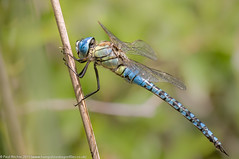 | Blue-eyed Hawker |
A medium-large (57 - 66mm), colourful migrant preferring well-vegetated shallow still waters which mostly dry out during summer.. A frequent visitor to the Thames basin in summer. | 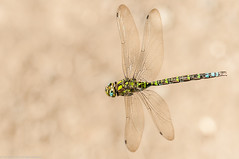 | Southern Hawker |
A large (70mm), colourful and inquisitive hawker preferring well-vegetated still waters, but may be found far from water on heaths and along forest rides |  | Brown Hawker | A large (73mm), fast and elusive hawker obvious golden brown wings. Preferring slow-flowing mud-based rivers, but may be found patrolling nearby lakes, ponds and streams. |
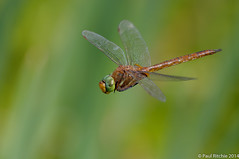 | Green-eyed Hawker |
A large, (63mm) hawker similar to the Brown Hawker but with clear wings and stunning green eyes. Currently only found in low-lying grazing meadows. fems & ditches in East Anglia and west Kent. | 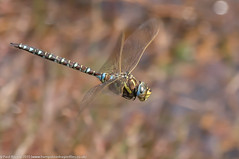 | Moorland Hawker | A large (65-80mm) hawker preferring moorland and mountain pools. Scarce in Hampshire but an occasional visitor to the New Forest where it can be found patrolling shallow acid ponds. | 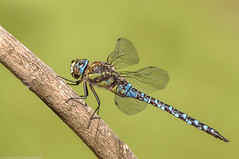 | Migrant Hawker |
A small (63mm) hawker found in large numbers patrolling well-vegetated water bodies. |  | Emperor Dragonfly | A large (78mm) and active dragonfly preferring well-vegetated standing water but may be found along canals and rivers. | 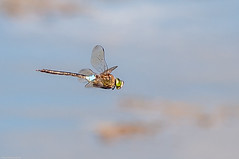 | Lesser Emperor | Similar to our own native Emperor Dragonfly but smaller and not as vibrant There is a bright blue "saddle" at S2 is very noticeable, even in flight. The rest of the abdomen and the thorax is brown while the eyes are bright green. | 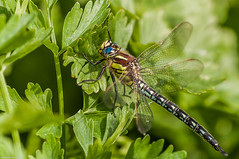 | Hairy Dragonfly |
A relatively small (55mm) hawker and the first hawker on the wing. Preferring unpolluted, well-vegetated water bodies. |
|
Cordulegastridae - Golden-ringed Dragonflies
Unmistakenly-marked large dragonfly | 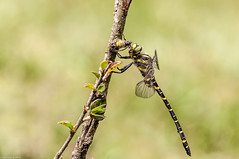 | Golden-ringed Dragonfly | A large (male-74mm, female-84mm) and impressive dragonfly, preferring acidic rivers and streams of all sizes. |
|
|
Corduliidae - Emerald Dragonflies
Metallic green with characteristic green eyes
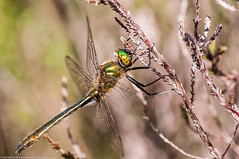 | | Downy Emerald | A moderately sized (48mm) dragonfly with a downy thorax and metallic green body with a copper sheen. |  | | Brilliant Emerald | A moderately sized (48mm)dragonfly superficially similar to Downy Emerald but with a more obvious metallic green body and apple green eyes. |
Gomphidae - Club-tailed Dragonflies
Medium-sized with yellow & black markings |  | Common Club-tail | This is a medium-sized (50mm) dragonfly with both sexes having a noticeably clubbed tail. |
|
|
Libellulidae - Chasers, Skimmers and Darters
Small to medium-sized dragonflies usually found in large numbers.
Usually perch low down and close to water
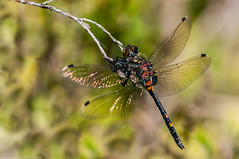 | | White-faced Darter |
The White-faced Darter is a small (33-37mm) dark dragonfly, with a pale creamy white frons. | 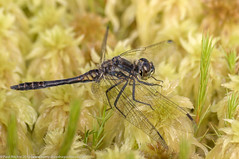 | | Black Darter | A small (29-34mm) moorland dragonfly found in peat moss and heaths, breeding in ponds, bog pools and drainage ditches. Can be found in large numbers locally. |  | | Red-veined Darter | This medium-sized (38-40mm) is a fairly frequent migrant to the UK and can be found at suitable sites along the south coast in reasonable numbers. |  | | Ruddy Darter | A very localised medium-sized (34-36mm) dragonfly which is superficially similar to the Common Darter. | 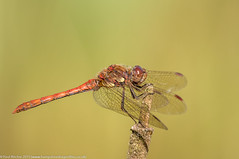 | | Common Darter | A very common medium-sized (34-36mm) dragonfly which is usually found in ponds and other still, or even brackish waters. | 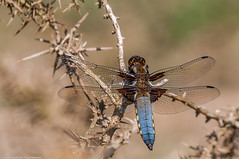 | | Broad-bodied Chaser |
A broad, stocky dragonfly (39-48mm) usually found in large numbers in ponds and perched along pondside edges. | 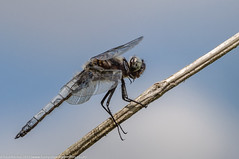 | | Scarce Chaser | A medium-sized ( 40-49mm) dragonfly of lowland river floodplains. | 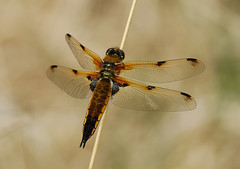 | | Four-spotted Chaser | A stocky medium-sized (39-48mm) dragonfly found in ponds and perched along pond edges. | 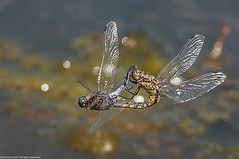 | | Black-tailed Skimmer |
A medium-sized (44-49mm) dragonfly found at many man-made open water such as gravel pits and old quarries. |  | | Keeled Skimmer | A medium-sized (40-44mm) dragonfly found in heathland ponds and streams often perched among the heather. |
|